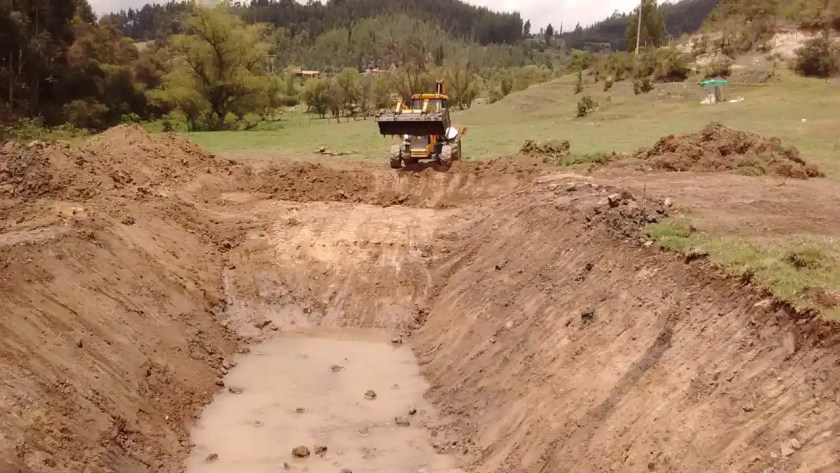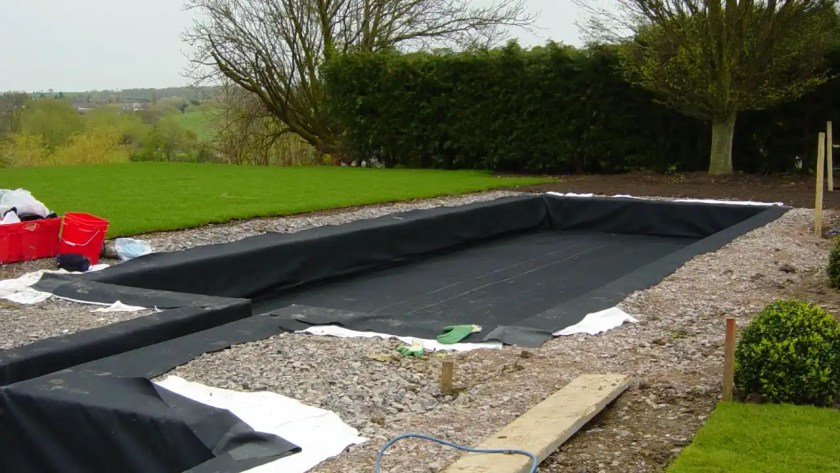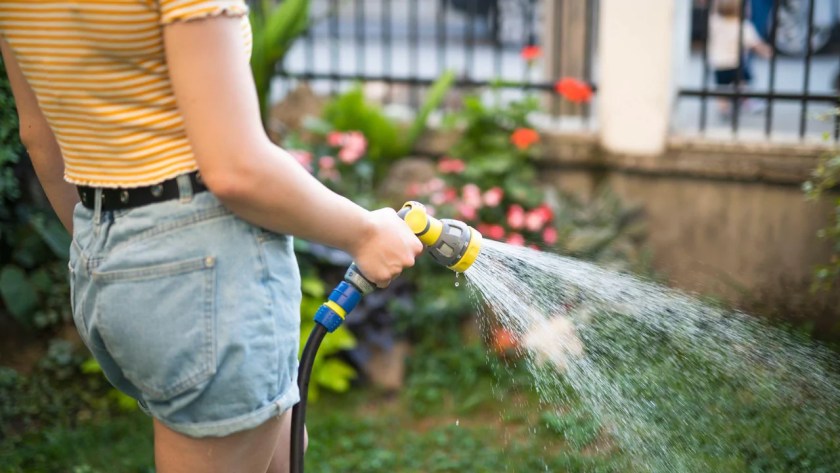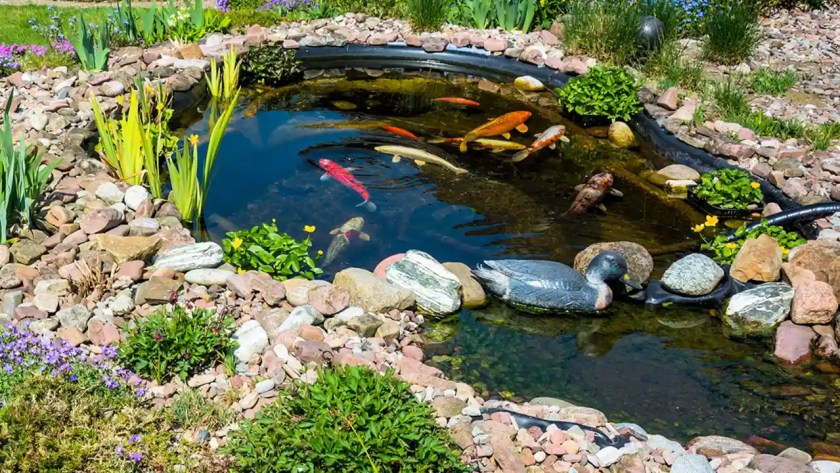Ponds are lovely features that enhance your property and bring wildlife and joy.
Along with the wildlife, a pond gives your home character and beauty, which is pleasant and peaceful to look at.
However, ponds require a little work to maintain, especially when filling and draining water.
You might be in the process of creating a new pond, or maybe the water levels are low in your existing pond.
What will you learn? This article will help you learn about everything there is to know about filling the pond with water and the different options to fill the pond. The article will also provide you with some additional information to help you adequately take care of a pond.
Steps To Fill a Pond with Water
Step 1: Dig a Hole

Prior to beginning the excavation, you may want to consider using a tarp or other large waterproof material to make a rough outline of the size of your wanted pond.
There are also pre-formed pond liners you may want to consider, which will give your water an additional layer of protection from the ground.
Dig out a hole within the outlined area while making sure it is deep enough to hold a minimum of half an inch of water.
Typically, however, the depth of the pond is relative to what you want the pond to be used for.
For example – If you want to have fish you will want the pond to be around 20 inches deep, which would hold a volume of 2000 liters. There is a formula to determine more accurately the depth/ size of the pond in liters: maximum length x maximum width x depth x 1000.
As every area is unique, when digging, you counsel in a location.
Ideally, a pond will get around 5 to 6 hours of sunlight each day, for the health of fish and plants.
If you dig too close to trees, you will have a good amount of leaf debris.
After you have dug out the hole, make sure you remove any large stones or other items that may puncture the pond liner.
You may also want to consider applying a 5 cm depth layer of sand below to prevent seeds from germinating.
Step 2: Lay out the liner

This is the point when you will install a pond liner in the freshly created pond.
Lay the liner in an open space around the pond, removing any excess pond liner.
If you are using a sided pond liner in a roll, just make sure that it is inside-out.
If it is in a straight-line pond liner, it will face up instead of down so that it will not tend to fray or tear easily when the time comes to put it over ground and fill it with water.
Then once the pond liner is well done, you can fill the pond with water.
Step 3: Fill the Pond with Water
This is the key step that also takes the longest.
You need to be extremely careful because you have to start from scratch if you make a small mistake.
Essentially, you want to get the water level to a certain level so that you are not flooding it and causing the liner to sag or to tear.
There are a variety of methods you can use to fill a pond with water.
Use Of Rainwater

This process consists of the natural filling of a pond from rainwater.
It may take a bit of time depending on the weather, but it is a current economic value as you will not spend anything to get the water.
If you are in a locality that gets rain frequently, this would be the best method.
If you live in a place that gets rain very infrequently, then this would not be the most practical way to fill your pond.
When compared to other methods, rainwater is the best way to fill a pond because of the perfect pH level – close to 7.
Even with the pH considerations, You have to be careful where the rainwater travels through prior to impounding the pond.
For example, roof spillover may be contaminated and harm the organisms in the pond.
For this reason – It would be best to gather rainwater and store it for three days before putting it into a pond- as this will lessen the effect of contamination.
Filling ponds with rainwater fills most applicable to small ponds as they will fill more quickly.
Use Of a Hosepipe

Using a hosepipe is another method for getting water into a pond.
It’s more expensive than using rainwater but is still very inexpensive. Furthermore, obtaining water through a hosepipe is fairly efficient and effective.
One disadvantage of using a hosepipe is that the water may be chlorinated, therefore potentially toxic for plants and animals living in the pond.
Read Later – Hose Pipe Splitter Buying Guide
Therefore, you may want to test the pH of the water before you put it into your pond. Anything under pH 7 is acidic.
To eliminate the issue:
- Use a water dechlorinator, which will be mentioned later in this article to stabilize the pH level.
- Clean the water using water conditioners that will extract chlorine and bacteria from the water.
Make sure the conditioner you are buying is safe for humans, plants, and animals before using.
Pump From Borehole

It is a relatively common practice to refill a pond with water drawn from a borehole.
Ultimately, you want to determine a practical and effective way to pump the water from the borehole into the pond.
One practical and simple way to transfer water from the borehole into the pond is to do so by tap.
It can also be accomplished using a hose.
Whenever you are filling a pond with a borehole, make sure that the ground surface is firm, and you remove any obstructions, including rocks and other debris.
It is economical as well as will not break your bank.
Water Providers
While this is the most expensive option, it is still the safest and most efficient option.
High-end options consist of professionally delivered water to your home.
When you can afford to add water to your pond with this option, it is typically treated, clean, and safe water.
However, this method is more sensible for smaller ponds that do not require too much water, as it may be too expensive for a larger pond.
Step 4: Fill the Pond with Fiona and Flora

Once the water is balanced in the pond, it will be time to fill it with plants and animals, such as fish, birds, and so on, according to your preference.
Plants create a relaxing atmosphere that will be tranquil to gaze at.
They are also a natural filter since they help clean the water.
Plants provide color and texture, which gives a pond its personality. The best plants to place in a pond are plants that are modified to live in aquatic conditions.
The most common animal to put in a fish is fish. There are several breeds of fish to put in pond water, one of which is koi fish.
Other critters that may enjoy pond water include birds.
If you want other animals to visit your pond, you will have to use various methods to attract them.
How Long Before Fish Can Go into A Pond After Filling It with Water?

Before the fish are added into the pond, there have to be plants already established in the pond, creating a suitable environment for fish.
As we have established in this article, the plants work as natural purifiers; hence they maintain water in a condition with suitable nutrition and environment for the health and survival of fish.
Also, the pH value should be between 7.2 and 7.8 before you add the fish into the pond.
Essentially-the temperature of the water should not exceed 60 degrees Fahrenheit. In general, one should wait for at least 3 days following the filling of the pond before putting in the fish.
Types Of Dechlorinators
Several types of dechlorinators can be applied to remove chlorine from chlorinated water in a pond. The types of dechlorinators include the following.
Chlorine Gas
This is the most frequently used type of dechlorinator.
It is commonly known for its use with other types of dechlorinators to inhibit bacterial growth. Chlorine is available in many concentrations.
Keep in mind that if you use 100% chlorine, it can be harmful or dangerous so it is recommended to dilute the chemical before using.
Sodium Thiosulfate
This is a family of chemicals that act as oxidizing agents.
These chemical agents break down chloramines and amines into less harmful species such as sulfites and ammonia.
Copper Sulfate
This is yet another dechlorinator that has been around for ages.
This is not the most common dechlorinator on the market now due to the high cost of its chemicals, but it has proven to work for many healthy and safe years going back over 15 years.
Additionally, it is cheap compared to any alternatives due to its availability at water treatment plants and various other locations internationally.
Calcium Hypochlorite
Calcium Hypochlorite is a chemical compound composed of calcium and chlorine, specifically Ca(OCl)2, which has soluble properties.
Upon dissolving in water, it produces hypochlorous acid, which is an oxidizing agent able to serve as both a disinfectant or a dechlorinator.
The mixture loses its active properties when it reaches the neutral pH which is convenient.
Taking Care of a Pond After Filling It with Water
Keep The Pond Clean
Always keep the water habitat clean and clear.
Use water purifying agents to decrease the amount of toxins in the water, and use nets or skimmers to remove leaves and debris.
Also, if water gets too warm, this can help cool it down!
In addition – avoid overfeeding the fish or putting in excess chemicals for the plants that pollute the water.
Shield The Pond
Keep people and unwanted animals from the outside world away from the pond.
Build a fence to separate the pond from the outside.
Implement some predator protection for the fish to hide under if predators do gain access.
There are spiraling fish tunnels, nets, and decoys, to mention a few.
Make Use of Beneficial Bacteria

This is a biological method to keep a pond pure after being filled with water.
The good bacteria decompose the fish wastes and keep the ammonia levels in the water as low as possible. Because high levels of ammonia are not safe for the fish and some of the plants.
An example of beneficial bacteria is the Nitrospira, which will convert the ammonia to nitrite and then to nitrate, which is non-toxic.
So, in effect, this bacteria will lower the ammonia levels.
There are several ways to get beneficial bacteria:
- You can buy refrigerated bacteria from the aquarium store.
- You can also get them from the sand or gravel of an established pond.
Remember that when the pond is freshly filled with water, it’s best to start with just a few fish since the fewer fish, the less amount of ammonia created.
Add fish as the pond gets more established.
Draining A Pond
In the event that you want to drain a pond filled with water, there are several different ways to drain a pond.
These methods will depend on the size and specific circumstance of the pond.
Use of a Water pump
This is by far the simplest process for removing water from a pond.
This method uses a submersible pump to extract water out of a pond using pressure.
The pressure moves water into the pump, reducing the energy you need to unload the water.
This method is ideal for smaller ponds.
Use Of Solar-Powered Pumps
While this method is comparatively slower, it is quite efficient.
As the name indicates, the pump uses energy from the sun to operate. Similar to the above pump, this pump does work best with smaller pumps.
The pump is slow because it pulls water seasonally. A couple of the pumps actual have built in aeration.
Use Of a Water Vacuum
A water vacuum is a great option for draining water quickly from small ponds and is in line with the pumps above.
It has the advantage of being pretty quick at draining water. It comes at a premium price, but the time saved can be well worth the investment if time is of the essence.
However, if you want to drain the pond completely, this is not your best option.
This is because it is best suited for draining pond water temporarily.
Use Of a Siphon Water Hose and Pump
Although it takes more labor and time than some other options, draining water out of a pond this way is the cheapest and surest method.
This method is a simple setup of a water hose with a pump on it that siphons water away from the pond by hand.
This method works well on a pond that is high up. If you the pump to get all of the water out of the pond, you will want a larger hand pump.
It’s a chore to do, but it may take some time to get it all done, but you can pick the amount you drain out of the pond.
Frequently Asked Questions

How long does it take to fill a pond?
The speed in which a pond fills also depends upon the method used and the size of the pond.
The smaller the pond, the faster it will fill, and also filling the pond with rainwater instead of professionally provided water will take considerably more time.
Can you build a pond anywhere?
In fact, you can build a pond almost anywhere, given the conditions are permissible.
For example, the location should be large enough to actually fit the pond unless we are talking about a miniature pond.
Also, consider your source of water. If it is rainwater, it should be positioned strategically enough that will catch as much water as possible.
If the plan is to attract wildlife, it should be built in an area that is obvious and accessible from wildlife.
Most importantly – you want to put it in a location where you can sit back and enjoy the beautiful views.
Do I need paper sleeves for the pond?

Paper sleeves are custom-made rubber sleeves that slip over the pipe in the pond to stop the leak.
You only need it when the pond has a filler or an overflow pipe.
Is it okay to use tap water to fill a pond?
You won’t hurt anything by using tap water to fill a pond.
But you have to be cautious of chlorinated tap water because the chemicals will impact the ecological system of your pond.
It is better to use a hose with clean tap water, and/or collect rainwater into your pond, in order to fill and maintain the ecosystem of your pond.
How big does a pond need to be?
The answer is up to you.
A lot depends on where you live, how much precipitation do you receive, how much sun do you receive, how likely is flooding, and when or how much you want to use it.
The best size is whatever is best for your own desires and resources.
Final Thoughts
If you’re looking to construct a pond or refill one already in place, we hope this article has been helpful.
There are several ways and methods to fill your pond with water including rainwater, boreholes, tap water, hose pipe, and water providers.
The best way & method is different for everyone. For some, it’s easy to use rain water, for others, it’s easier to get water from a water provider.
No matter how you fill your pond with water, just be sure the water is clean and safe for the flora and Fiona.
If the water contains chlorine, use the de-chlorinators mentioned in the article to clean the water!